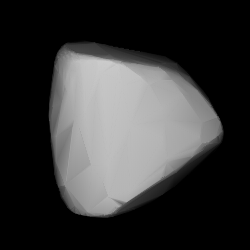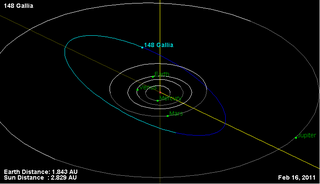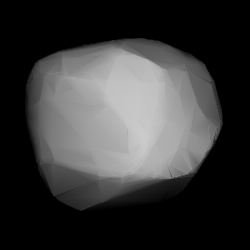
Dike is a quite large and dark main-belt asteroid. Dike was discovered by Alphonse Borrelly on May 28, 1868. It was his first asteroid discovery. This object is named after Dike, the Greek goddess of moral justice. Among the first hundred numbered minor planets, 99 Dike was considered anomalously faint for over a century. However, this was later found to be untrue.

Hera is a moderately large main-belt asteroid with an orbital period of 4.44 years. It was discovered by Canadian-American astronomer James Craig Watson on September 7, 1868, and named after Hera, queen and fifth in power of the Olympian gods in Greek mythology. This is a stony S-type asteroid with a silicate surface composition.

Nemesis is a large 180 km main-belt asteroid, of carbonaceous composition. It rotates rather slowly, taking about 78 hours to complete one rotation. Nemesis is the largest member of the Nemesian asteroid family bearing its name. It was discovered by J. C. Watson on 25 November 1872, and named after Nemesis, the goddess of retribution in Greek mythology.

Gallia is an asteroid from the central regions of the asteroid belt, approximately 90 kilometers in diameter. It was discovered on 7 August 1875, by the French brothers Paul Henry and Prosper Henry at the Paris, but the credit for this discovery was given to Prosper. It was named after the Latin name for the country of France, Gaul. Based upon its spectrum, it is an unusual G-type asteroid (GU) and a stony S-type asteroid in the Tholen and SMASS classification, respectively.

Koronis is a main-belt asteroid that was discovered by Russian astronomer Viktor Knorre on January 4, 1876, from the Berlin observatory. It was the first of his four asteroid discoveries. The meaning of the asteroid name is uncertain, but it may come from Coronis the mother of Asclepius from Greek mythology. Alternatively, it may come from Coronis, a nymph of the Hyades sisterhood. The Koronis family is named after this asteroid.

Aemilia is a large main-belt asteroid. Aemilia was discovered by the French brothers Paul Henry and Prosper Henry on January 26, 1876. The credit for this discovery was given to Paul. It is probably named after the Via Aemilia, a Roman road in Italy that runs from Piacenza to Rimini.

Eucharis is a large, slowly rotating main-belt asteroid that was discovered by French astronomer Pablo Cottenot on February 2, 1878, from Marseille Observatory. It was his only asteroid discovery. This object was named after Eucharis, a nymph from the 17th-century novel Les Aventures de Télémaque.

225 Henrietta is a very large outer main-belt asteroid. It was discovered by Austrian astronomer Johann Palisa on April 19, 1882, in Vienna and named after Henrietta, wife of astronomer Pierre J. C. Janssen. The asteroid is orbiting at a distance of 3.39 AU from the Sun with a period of 6.24 years and an eccentricity (ovalness) of 0.26. The orbital plane is inclined at an angle of 20.9° to the plane of the ecliptic. 225 Henrietta belongs to Cybele group of asteroids and is probably in a 4:7 orbital resonance with the planet Jupiter.

Florentina is an S-type (stony) main belt asteroid with a diameter of 28 km. It was discovered by Johann Palisa on 15 October 1891 in Vienna. He named the asteroid for his daughter, Florentine. Between 1874 and 1923, Palisa discovered a total of 122 asteroids.

Aeolia is a typical main belt asteroid. It was discovered by the French astronomer Auguste Charlois on 1 December 1894 from Nice, and may have been named for the ancient land of Aeolis. The asteroid is orbiting the Sun at a distance of 2.74 AU with a period of 4.54 years and an eccentricity (ovalness) of 0.16. The orbital plane is inclined at an angle of 2.5° to the plane of the ecliptic. This is the largest member of the eponymously named Aeolia asteroid family, a small group of asteroids with similar orbits that have an estimated age of less than 100 million years.
Friederike is a minor planet orbiting in the asteroid belt. It is a member of the Hygiea family of asteroids.
630 Euphemia is a mid-sized Eunomian asteroid.
740 Cantabia is a minor planet orbiting the Sun. It was discovered on 10 February 1913 at Winchester, Massachusetts by American amateur astronomer J. H. Metcalf. Cantabia is a contraction of Cantabrigia, Latin for Cambridge, named in honor of Cambridge, Massachusetts. It is orbiting at a distance of 3.05 AU with a period of 5.33 years and an eccentricity (ovalness) of 0.11. Between 2014 and 2021, 740 Cantabia has been observed to occult three stars.
780 Armenia is a minor planet in the asteroid belt orbiting the Sun. It is named after the Kingdom of Armenia, now Armenia. This object is orbiting at a distance of 3.11 AU with an eccentricity of 0.097 and a period of 5.50 yr. The orbital plane is inclined at an angle of 19.1° to the plane of rotation. This asteroid spans a girth of ~94 km. The long rotation period of this asteroid necessitated light curve data from more than one latitude. The overlapping data provided a solution with a period of 19.891±0.002 h and a brightness amplitude of 0.18±0.03 in magnitude.
781 Kartvelia is a minor planet orbiting the Sun that was discovered by Russian astronomer Grigory Neujmin on January 25, 1914. Kartvelia comes from the historic name for the inhabitants of the nation of Georgia. This object is orbiting at a distance of 3.22 AU with an eccentricity (ovalness) of 0.12 and a period of 5.78 yr. The orbital plane is inclined at an angle of 19.1° to the plane of the ecliptic.

875 Nymphe is a minor planet orbiting the Sun. It is a member of the Maria family of asteroids.
1101 Clematis is an Alauda asteroid from the outermost regions of the asteroid belt, approximately 37 kilometers in diameter. It was discovered on 22 September 1928, by German astronomer Karl Reinmuth at the Heidelberg-Königstuhl State Observatory in southwest Germany, and assigned the provisional designation 1928 SJ. It was named for the flowering plant Clematis. The presumably carbonaceous asteroid has a relatively long rotation period of 34.3 hours.
1754 Cunningham, provisional designation 1935 FE, is a Hildian asteroid from the outermost region of the asteroid belt, approximately 80 kilometers in diameter.
1345 Potomac, provisional designation 1908 CG, is a dark Hildian asteroid from the outermost regions of the asteroid belt, approximately 73 kilometers (45 mi) in diameter. It was discovered on 4 February 1908, by American astronomer Joel Metcalf at the Taunton Observatory in Massachusetts, United States. The X-type asteroid has a rotation period of 11.4 hours. It was named for the Potomac River on which Washington, D.C. is located.
2903 Zhuhai, provisional designation 1981 UV9, is a stony background or Marian asteroid from the central regions of the asteroid belt, approximately 14 kilometers (8.7 miles) in diameter. It was discovered on 23 October 1981, by astronomers at Purple Mountain Observatory near Nanking, China. The S-type asteroid has a rotation period of 5.26 hours. It was named for the Chinese city of Zhuhai.











